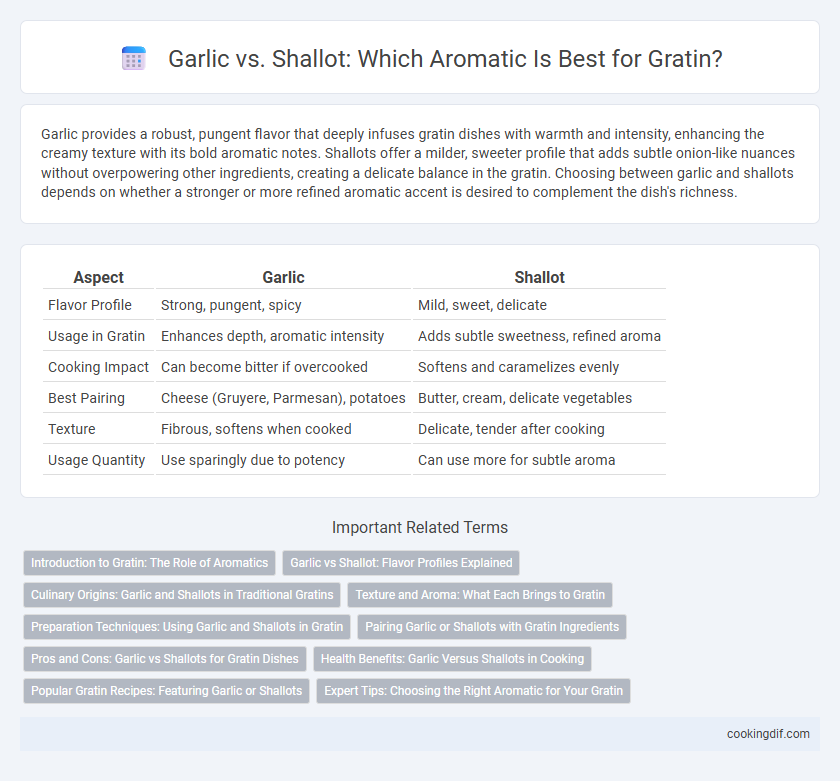Garlic provides a robust, pungent flavor that deeply infuses gratin dishes with warmth and intensity, enhancing the creamy texture with its bold aromatic notes. Shallots offer a milder, sweeter profile that adds subtle onion-like nuances without overpowering other ingredients, creating a delicate balance in the gratin. Choosing between garlic and shallots depends on whether a stronger or more refined aromatic accent is desired to complement the dish's richness.
Table of Comparison
| Aspect | Garlic | Shallot |
|---|---|---|
| Flavor Profile | Strong, pungent, spicy | Mild, sweet, delicate |
| Usage in Gratin | Enhances depth, aromatic intensity | Adds subtle sweetness, refined aroma |
| Cooking Impact | Can become bitter if overcooked | Softens and caramelizes evenly |
| Best Pairing | Cheese (Gruyere, Parmesan), potatoes | Butter, cream, delicate vegetables |
| Texture | Fibrous, softens when cooked | Delicate, tender after cooking |
| Usage Quantity | Use sparingly due to potency | Can use more for subtle aroma |
Introduction to Gratin: The Role of Aromatics
Garlic and shallot both enhance gratin with distinct aromatic profiles; garlic offers a robust, pungent flavor that deeply infuses creamy gratin layers, while shallot imparts a milder, sweeter, and more delicate onion nuance that complements the rich textures without overpowering. Balancing garlic's intensity with shallot's subtlety can elevate gratin's overall complexity, creating a harmonious depth of flavor. Selecting between garlic or shallot depends on the desired aromatic emphasis, influencing the dish's final sensory experience.
Garlic vs Shallot: Flavor Profiles Explained
Garlic provides a robust, pungent flavor with a slightly spicy undertone that intensifies when roasted, making it ideal for bold gratin dishes. Shallots offer a milder, sweeter taste with subtle hints of onion and garlic, adding a delicate aromatic depth without overpowering other ingredients. Choosing between garlic and shallot in gratins depends on whether a strong, savory punch or a gentle, nuanced aroma is desired.
Culinary Origins: Garlic and Shallots in Traditional Gratins
Garlic and shallots both play distinct roles in traditional gratin recipes, with garlic often linked to Mediterranean cuisine where its pungent flavor enhances creamy gratins like gratin dauphinois. Shallots, originating from French culinary traditions, contribute a milder, sweeter aromatic profile ideal for delicate gratin dishes such as gratin de courgettes. The choice between garlic and shallots in gratin reflects regional preferences and desired flavor intensities, balancing richness with subtle aromatic complexity.
Texture and Aroma: What Each Brings to Gratin
Garlic contributes a robust, pungent aroma and a slightly grainy texture that intensifies as it cooks, enhancing the savory depth of gratin dishes. Shallots offer a milder, sweeter fragrance with a smoother, silkier texture that melds seamlessly into creamy gratins, creating subtle sweetness without overpowering other flavors. Choosing garlic sharpens the dish's aromatic profile, while shallots provide a balanced, delicate undertone that complements the rich, cheesy components of gratin.
Preparation Techniques: Using Garlic and Shallots in Gratin
Garlic in gratin is typically minced or thinly sliced to release its pungent flavor that infuses creamy layers during baking. Shallots require fine dicing or slow sauteing until caramelized, enhancing sweetness and subtle onion notes without overpowering the dish. Proper preparation of these aromatics ensures balanced flavor integration, elevating the gratin's savory profile.
Pairing Garlic or Shallots with Gratin Ingredients
Garlic enhances gratin dishes with its robust, pungent flavor that deepens the taste of creamy potatoes and cheese, creating a savory, aromatic base. Shallots offer a milder, sweeter profile that complements delicate gratin components like leeks or mushrooms, adding subtle complexity without overpowering. Both garlic and shallots work well with thyme, Gruyere, and cream, balancing richness and elevating the overall flavor harmony in gratin recipes.
Pros and Cons: Garlic vs Shallots for Gratin Dishes
Garlic delivers a robust, pungent flavor that enhances gratin dishes with its sharp, savory notes, but it can overpower delicate ingredients and become bitter if overcooked. Shallots offer a milder, sweeter aroma that blends smoothly into creamy gratins, providing subtle onion undertones without overwhelming the dish. Choosing between garlic and shallots depends on the desired flavor intensity and balance, with garlic best for bold, aromatic profiles and shallots ideal for gentle, nuanced layering.
Health Benefits: Garlic Versus Shallots in Cooking
Garlic contains allicin, a compound with potent antioxidant and anti-inflammatory properties that may support cardiovascular health and boost immunity, making it a powerful aromatic choice for gratin dishes. Shallots provide a milder flavor with high levels of quercetin and kaempferol, antioxidants known for reducing inflammation and promoting heart health while being gentler on digestion. Using garlic in gratin adds robust health benefits linked to antimicrobial effects, whereas shallots contribute subtle antioxidants for a balanced, health-conscious flavor profile.
Popular Gratin Recipes: Featuring Garlic or Shallots
Popular gratin recipes frequently highlight the distinctive aromas of garlic or shallots to elevate their rich, creamy textures. Garlic offers a bold, pungent flavor ideal for traditional potato gratins and vegetable casseroles, infusing dishes with a warm, savory depth. Shallots provide a milder, sweeter note, enhancing gratins with subtle complexity ideal for recipes featuring delicate ingredients like zucchini or mushrooms.
Expert Tips: Choosing the Right Aromatic for Your Gratin
Garlic imparts a robust, pungent flavor that deepens the savory profile of gratin, ideal for dishes requiring bold aromatic intensity. Shallots offer a milder, sweeter taste with subtle onion nuances, enhancing gratins with a delicate, nuanced aroma without overpowering other ingredients. Expert chefs recommend selecting garlic for rustic, hearty gratins and shallots for refined, elegant preparations to balance flavor complexity.
Garlic vs Shallot for aromatics Infographic

 cookingdif.com
cookingdif.com